Unbiased and Signal-Weakening Photoelectrochemical Hexavalent Chromium Sensing via a CuO Film Photocathode
Abstract
1. Introduction
2. Materials and Methods
2.1. Materials and Reagents
2.2. Preparation of the CuO Film Photoelectrode
2.3. Material Characterizations
2.4. Photoelectrochemical Measurements
3. Results and Discussion
| Sensing Component | Test Conditions | Sensitivity (µA μM−1) | Linear Range (µM) | LOD (µM) | Method | Ref. |
|---|---|---|---|---|---|---|
| FTO/TiO2/Au NPs photoanode | −0.2 V b Simulated sunlight | 11.88 | 0.01–100 | 0.004 | PEC Signal enhancing | [18] |
| Bi/BiPO4/BiOI photocathode | −0.2 V b Visible light | 0.315 0.111 | 0.5–10 10–180 | 0.3 | PEC Signal enhancing | [19] |
| FTO/TiO2 NRs/Au NPs photoanode | −0.2 V b Simulated sunlight | 13.94 | 0.01–50 | 0.006 | PEC Signal enhancing | [31] |
| BiOI/CN photoanode | 0.3 V b Visible light | 0.0027 0.0003 | 0.5–15 15–190 | 0.1 | PEC Signal enhancing | [32] |
| ITO/MoS2/BiOI photocathode | 0 V b Visible light | 0.3174 0.0388 | 0.05–10 10–160 | 0.01 | PEC Signal enhancing | [33] |
| Ti/TiO2 NTA/NiCoLDHs photoanode | 0 V a UV light | 2.15 lgC 6.50 lgC 1.10 lgC | 0.5–20 20–40 400–1800 | 0.12 | PEC Signal weakening | [38] |
| BiVO4 photoanode | 0.4 V Visible light | 0.123 logC | 2–10 | 0.01 | PEC Signal enhancing | [39] |
| Ti/TiO2 NTs/Au NPs electrode | 0.28 V a | 6.91 | 0.1–105 | 0.03 | EC | [40] |
| GCE/Ag film electrode | 0.59 V a | 1.590 | 0.35–40 | 0.1 | EC | [41] |
| MWCNTs/Au NPs electrode | 0.52 V b | 0.28 | 0.8–230 | 0.72 | EC | [42] |
| FTO/CuO film photocathode | Rel 0 V b Simulated sunlight | 4.22 | 0.08–2 | 0.0028 | PEC Signal weakening | This work |
4. Conclusions
Author Contributions
Funding
Institutional Review Board Statement
Informed Consent Statement
Data Availability Statement
Conflicts of Interest
References
- Saha, R.; Nandi, R.; Saha, B. Sources and Toxicity of Hexavalent Chromium. J. Coord. Chem. 2011, 64, 1782–1806. [Google Scholar] [CrossRef]
- DesMarias, T.L.; Costa, M. Mechanisms of Chromium-Induced Toxicity. Curr. Opin. Toxicol. 2019, 14, 1–7. [Google Scholar] [CrossRef] [PubMed]
- Novotnik, B.; Zuliani, T.; Martinčič, A.; Ščančar, J.; Milačič, R. Preparation of Cr(VI) and Cr(III) Isotopic Spike Solutions from 50Cr and 53Cr Enriched Oxides without the Use of Oxidizing and/or Reducing Agents. Talanta 2012, 99, 83–90. [Google Scholar] [CrossRef] [PubMed]
- World Health Organization Guidelines for Drinking-Water Quality [Electronic Resource]: Incorporating 1st and 2nd Addenda, Vol.1, Recommendations, 3rd ed.; World Health Organization: Geneva, Switzerland, 2008; ISBN 978-92-4-154761-1.
- Yang, Y.; Lu, L.; Shen, Y.; Wang, J.; Li, L.; Ma, R.; Ullah, Z.; Xiang, M.; Yu, Y. Asymmetric Alternative Current Electrochemical Method Coupled with Amidoxime-Functionalized Carbon Felt Electrode for Fast and Efficient Removal of Hexavalent Chromium from Wastewater. Nanomaterials 2023, 13, 952. [Google Scholar] [CrossRef] [PubMed]
- Gao, F.; Zhang, L.; Yang, L.; Zhou, X.; Zhang, Y. Structural Properties of Graphene Oxide Prepared from Graphite by Three Different Methods and the Effect on Removal of Cr(VI) from Aqueous Solution. Nanomaterials 2023, 13, 279. [Google Scholar] [CrossRef]
- García, A.; Rodríguez, B.; Rosales, M.; Quintero, Y.M.; Saiz, P.G.; Reizabal, A.; Wuttke, S.; Celaya-Azcoaga, L.; Valverde, A.; Fernández de Luis, R. A State-of-the-Art of Metal-Organic Frameworks for Chromium Photoreduction vs. Photocatalytic Water Remediation. Nanomaterials 2022, 12, 4263. [Google Scholar] [CrossRef]
- Nafti, M.; Chakroun, R.; Hannachi, C.; Hamrouni, B.; Nouaïgui, H. Determination of Chromium (VI) in Airborne Particulate Matter by Electrothermal Atomic Absorption Spectrometry. Anal. Lett. 2017, 50, 2012–2022. [Google Scholar] [CrossRef]
- Song, J.; Zhou, H.; Gao, R.; Zhang, Y.; Zhang, H.; Zhang, Y.; Wang, G.; Wong, P.K.; Zhao, H. Selective Determination of Cr(VI) by Glutaraldehyde Cross-Linked Chitosan Polymer Fluorophores. ACS Sens. 2018, 3, 792–798. [Google Scholar] [CrossRef]
- Sereshti, H.; Vasheghani Farahani, M.; Baghdadi, M. Trace Determination of Chromium(VI) in Environmental Water Samples Using Innovative Thermally Reduced Graphene (TRG) Modified SiO2 Adsorbent for Solid Phase Extraction and UV–Vis Spectrophotometry. Talanta 2016, 146, 662–669. [Google Scholar] [CrossRef]
- Inoue, Y.; Sakai, T.; Kumagai, H. Simultaneous Determination of Chromium(III) and Chromium(VI) by Ion Chromatography with Inductively Coupled Plasma Mass Spectrometry. J. Chromatogr. A 1995, 706, 127–136. [Google Scholar] [CrossRef]
- Wang, C.; Shang, M.; Wei, H.; Zhang, M.; Zou, W.; Meng, X.; Chen, W.; Shao, H.; Lai, Y. Specific and Sensitive On-Site Detection of Cr(VI) by Surface-Enhanced Raman Spectroscopy. Sens. Actuators B Chem. 2021, 346, 130594. [Google Scholar] [CrossRef]
- Chen, B.-H.; Jiang, S.-J.; Sahayam, A.C. Determination of Cr(VI) in Rice Using Ion Chromatography Inductively Coupled Plasma Mass Spectrometry. Food Chem. 2020, 324, 126698. [Google Scholar] [CrossRef]
- Karami, H.; Mousavi, M.F.; Yamini, Y.; Shamsipur, M. On-Line Preconcentration and Simultaneous Determination of Heavy Metal Ions by Inductively Coupled Plasma-Atomic Emission Spectrometry. Anal. Chim. Acta. 2004, 509, 89–94. [Google Scholar] [CrossRef]
- Hilali, N.; Mohammadi, H.; Amine, A.; Zine, N.; Errachid, A. Recent Advances in Electrochemical Monitoring of Chromium. Sensors 2020, 20, 5153. [Google Scholar] [CrossRef]
- Zhao, W.-W.; Xu, J.-J.; Chen, H.-Y. Photoelectrochemical Detection of Metal Ions. Analyst 2016, 141, 4262–4271. [Google Scholar] [CrossRef]
- Wen, L.; Nan, X.; Li, J.; Cumming, D.R.S.; Hu, X.; Chen, Q. Broad-Band Spatial Light Modulation with Dual Epsilon-near-Zero Modes. Opto-Electron. Adv. 2022, 5, 200093. [Google Scholar] [CrossRef]
- Siavash Moakhar, R.; Goh, G.K.L.; Dolati, A.; Ghorbani, M. A Novel Screen-printed TiO2 Photoelectrochemical Sensor for Direct Determination and Reduction of Hexavalent Chromium. Electrochem. Commun. 2015, 61, 110–113. [Google Scholar] [CrossRef]
- Li, M.; Zhang, G.; Feng, C.; Wu, H.; Mei, H. Highly Sensitive Detection of Chromium (VI) by Photoelectrochemical Sensor under Visible Light Based on Bi SPR-Promoted BiPO4/BiOI Heterojunction. Sens. Actuators B Chem. 2020, 305, 127449. [Google Scholar] [CrossRef]
- Won, D.H.; Choi, C.H.; Chung, J.; Woo, S.I. Photoelectrochemical Production of Formic Acid and Methanol from Carbon Dioxide on Metal-Decorated CuO/Cu2O-Layered Thin Films under Visible Light Irradiation. Appl. Catal. B 2014, 158–159, 217–223. [Google Scholar] [CrossRef]
- Huang, Q.; Kang, F.; Liu, H.; Li, Q.; Xiao, X. Highly Aligned Cu2O/CuO/TiO2 Core/Shell Nanowire Arrays as Photocathodes for Water Photoelectrolysis. J. Mater. Chem. A 2013, 1, 2418–2425. [Google Scholar] [CrossRef]
- Yu, J.; Zhuang, S.; Xu, X.; Zhu, W.; Feng, B.; Hu, J. Photogenerated Electron Reservoir in Hetero-p-n CuO-ZnO Nanocomposite Device for Visible-Light-Driven Photocatalytic Reduction of Aqueous Cr(VI). J. Mater. Chem. A 2015, 3, 1199–1207. [Google Scholar] [CrossRef]
- Gupta, V.K.; Chandra, R.; Tyagi, I.; Verma, M. Removal of Hexavalent Chromium Ions Using CuO Nanoparticles for Water Purification Applications. J. Colloid Interface Sci. 2016, 478, 54–62. [Google Scholar] [CrossRef] [PubMed]
- Cory, N.J.; Visser, E.; Chamier, J.; Sackey, J.; Cummings, F.; Chowdhury, M. Electrodeposited CuO Thin Film for Wide Linear Range Photoelectrochemical Glucose Sensing. Appl. Surf. Sci. 2022, 576, 151822. [Google Scholar] [CrossRef]
- Biesinger, M.C. Advanced Analysis of Copper X-ray Photoelectron Spectra: Advanced Analysis of Copper X-ray Photoelectron Spectra. Surf. Interface Anal. 2017, 49, 1325–1334. [Google Scholar] [CrossRef]
- Zhou, Q.; Li, T.-T.; Xu, W.; Zhu, H.-L.; Zheng, Y.-Q. Ultrathin Nanosheets-Assembled CuO Flowers for Highly Efficient Electrocatalytic Water Oxidation. J. Mater. Sci. 2018, 53, 8141–8150. [Google Scholar] [CrossRef]
- Dey, A.; Chandrabose, G.; Ghosh, P.; Damptey, L.A.O.; Clark, A.H.; Selvaraj, V.; Kumar, R.V.; Braithwaite, N.S.J.; Zhuk, S.; Dalapati, G.K.; et al. Atmospheric Pressure Plasma Engineered Superhydrophilic CuO Surfaces with Enhanced Catalytic Activities. Appl. Surf. Sci. 2021, 564, 150413. [Google Scholar] [CrossRef]
- Masudy-Panah, S.; Moakhar, R.S.; Chua, C.S.; Kushwaha, A.; Wong, T.I.; Dalapati, G.K. Rapid Thermal Annealing Assisted Stability and Efficiency Enhancement in a Sputter Deposited CuO Photocathode. RSC Adv. 2016, 6, 29383–29390. [Google Scholar] [CrossRef]
- Yang, C.P.; Wu, Q.; Jiang, Z.W.; Wang, X.; Huang, C.Z.; Li, Y.F. Cu Vacancies Enhanced Photoelectrochemical Activity of Metal-Organic Gel-Derived CuO for the Detection of l-Cysteine. Talanta 2021, 228, 122261. [Google Scholar] [CrossRef]
- Kim, J.; Wong, S.; Kim, G.; Park, Y.-B.; van Embden, J.; Della Gaspera, E. Transparent Electrodes Based on Spray Coated Fluorine-Doped Tin Oxide with Enhanced Optical, Electrical and Mechanical Properties. J. Mater. Chem. C 2020, 8, 14531–14539. [Google Scholar] [CrossRef]
- Siavash Moakhar, R.; Goh, G.K.L.; Dolati, A.; Ghorbani, M. Sunlight-Driven Photoelectrochemical Sensor for Direct Determination of Hexavalent Chromium Based on Au Decorated Rutile TiO2 Nanorods. Appl. Catal. B 2017, 201, 411–418. [Google Scholar] [CrossRef]
- Cheng, D.; Wu, H.; Feng, C.; Zhang, Y.; Ding, Y.; Mei, H. Highly Sensitive Detection of Chromium (VI) by Photoelectrochemical Sensor Based on p-n Heterojunction of Carbon Nitride-Modified BiOI. J. Alloys Compd. 2021, 882, 160690. [Google Scholar] [CrossRef]
- Chen, R.; Tang, R.; Chen, C. Photoelectrochemical Detection of Chromium (VI) Using Layered MoS2 Modified BiOI. J. Chem. Sci. 2020, 132, 54. [Google Scholar] [CrossRef]
- Wang, T.; Liu, Y.; Wang, J.; Wang, X.; Liu, B.; Wang, Y. In-Situ Remediation of Hexavalent Chromium Contaminated Groundwater and Saturated Soil Using Stabilized Iron Sulfide Nanoparticles. J. Environ. Manag. 2019, 231, 679–686. [Google Scholar] [CrossRef]
- Song, Y.; Lu, X.; Liu, Z.; Liu, W.; Gai, L.; Gao, X.; Ma, H. Efficient Removal of Cr(VI) by TiO2 Based Micro-Nano Reactor via the Synergy of Adsorption and Photocatalysis. Nanomaterials 2022, 12, 291. [Google Scholar] [CrossRef]
- Wang, X.; Pehkonen, S.O.; Ray, A.K. Removal of Aqueous Cr(VI) by a Combination of Photocatalytic Reduction and Coprecipitation. Ind. Eng. Chem. Res. 2004, 43, 1665–1672. [Google Scholar] [CrossRef]
- Qiao, J.; Wang, Y.; Liang, Q.; Dong, S.; Zeng, Z.; Shao, S. A Photoelectrochemical Sensor Based on TiO2 Nanotube Arrays Decorated with Nickel-Cobalt Layered Double Hydroxides for the Effective and Sensitive Detection of Chromium(VI). ACS Appl. Nano Mater. 2022, 5, 5535–5543. [Google Scholar] [CrossRef]
- Zhang, Q.; Wang, M.; Ao, M.; Luo, Y.; Zhang, A.; Zhao, L.; Yan, L.; Deng, F.; Luo, X. Solvothermal Synthesis of Z-Scheme AgIn5S8/Bi2WO6 Nano-Heterojunction with Excellent Performance for Photocatalytic Degradation and Cr(VI) Reduction. J. Alloys Compd. 2019, 805, 41–49. [Google Scholar] [CrossRef]
- Wu, W.; Tan, Z.; Chen, X.; Chen, X.; Cheng, L.; Wu, H.; Li, P.; Zhang, Z. Carnation-like Morphology of BiVO4-7 Enables Sensitive Photoelectrochemical Determination of Cr(VI) in the Food and Environment. Biosensors 2022, 12, 130. [Google Scholar] [CrossRef]
- Jin, W.; Wu, G.; Chen, A. Sensitive and Selective Electrochemical Detection of Chromium(VI) Based on Gold Nanoparticle-Decorated Titania Nanotube Arrays. Analyst 2014, 139, 235–241. [Google Scholar] [CrossRef]
- Stojanović, Z.; Koudelkova, Z.; Sedlackova, E.; Hynek, D.; Richtera, L.; Adam, V. Determination of Chromium(VI) by Anodic Stripping Voltammetry Using a Silver-Plated Glassy Carbon Electrode. Anal. Methods 2018, 10, 2917–2923. [Google Scholar] [CrossRef]
- Breslin, C.B.; Branagan, D.; Garry, L.M. Electrochemical Detection of Cr(VI) with Carbon Nanotubes Decorated with Gold Nanoparticles. J. Appl. Electrochem. 2019, 49, 195–205. [Google Scholar] [CrossRef]
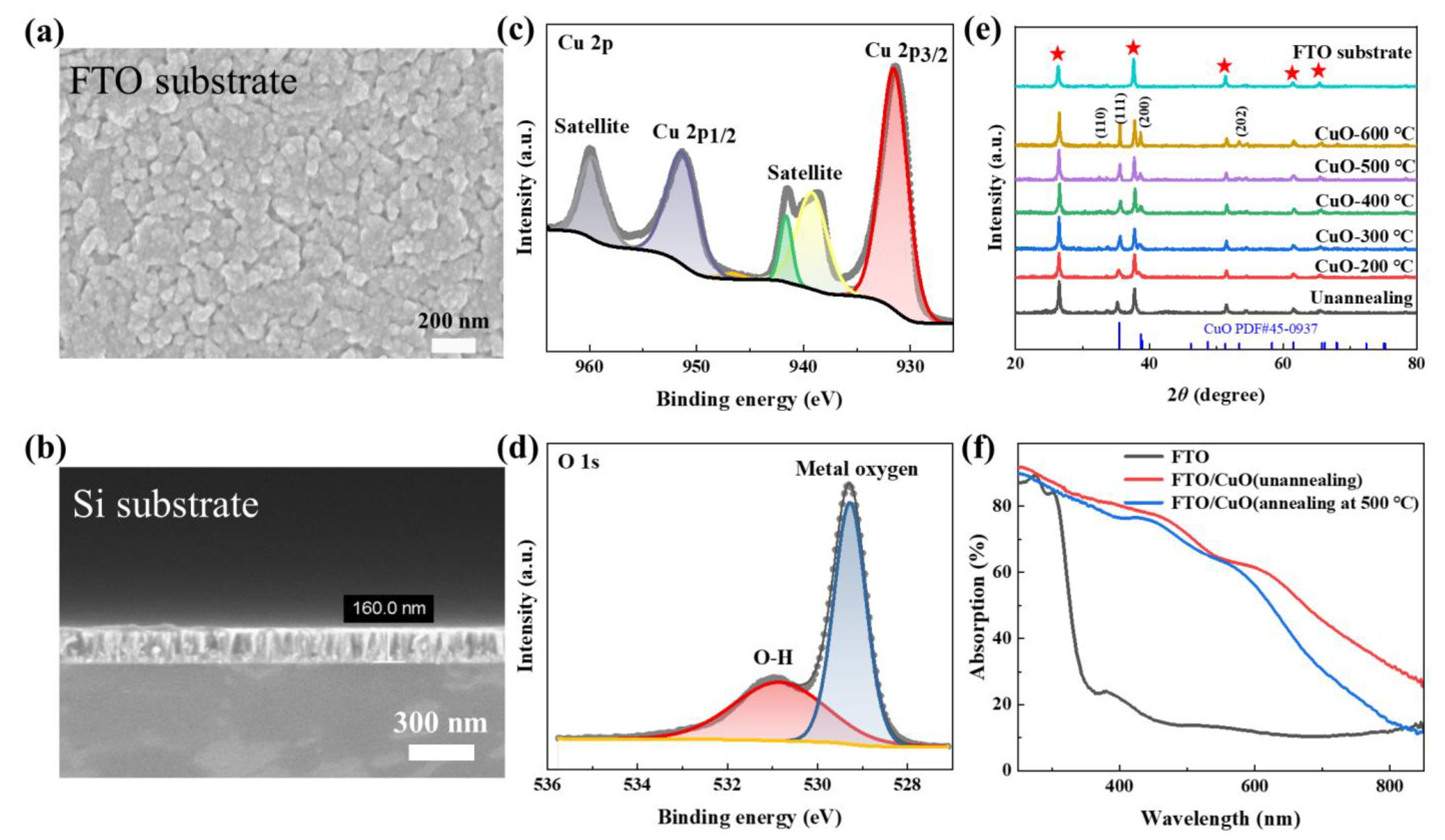
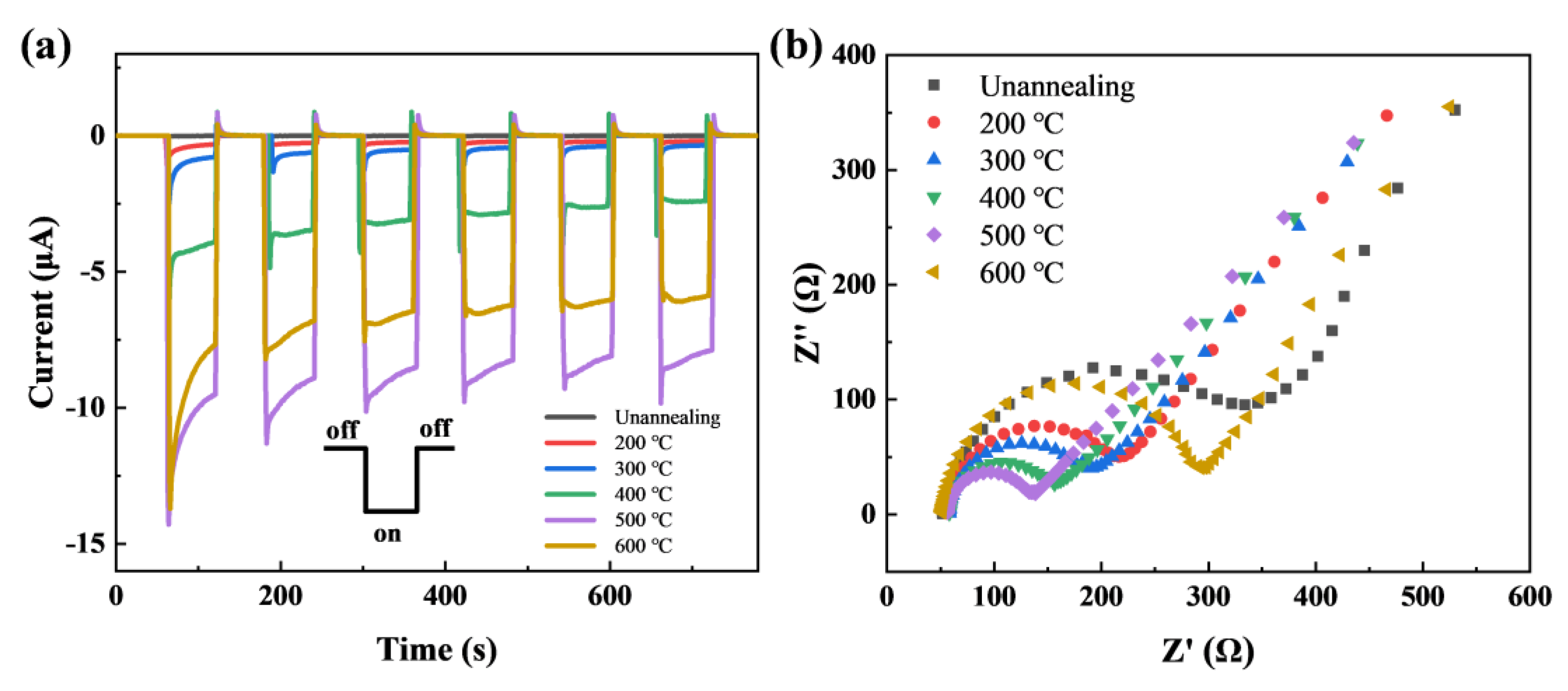
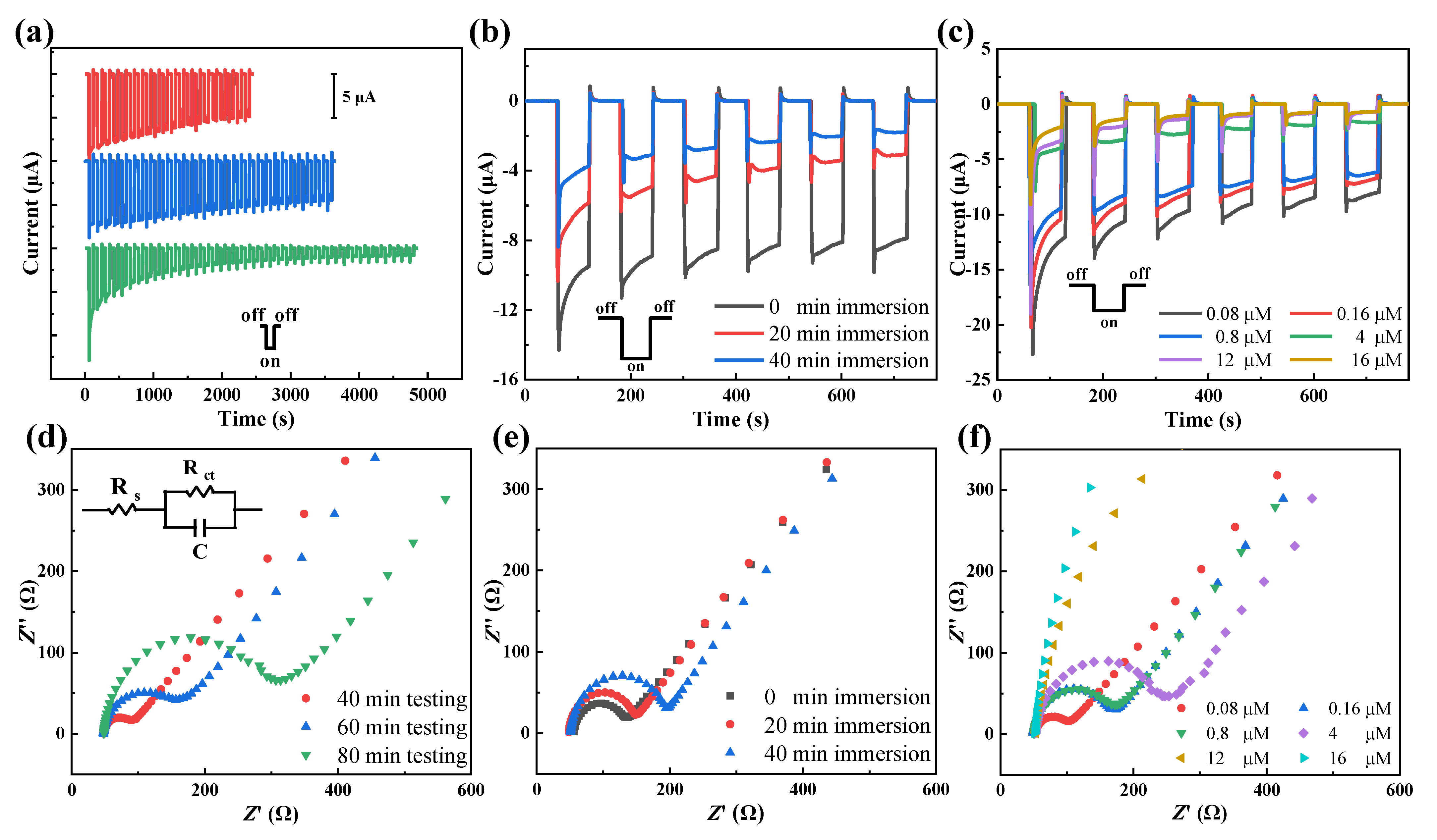
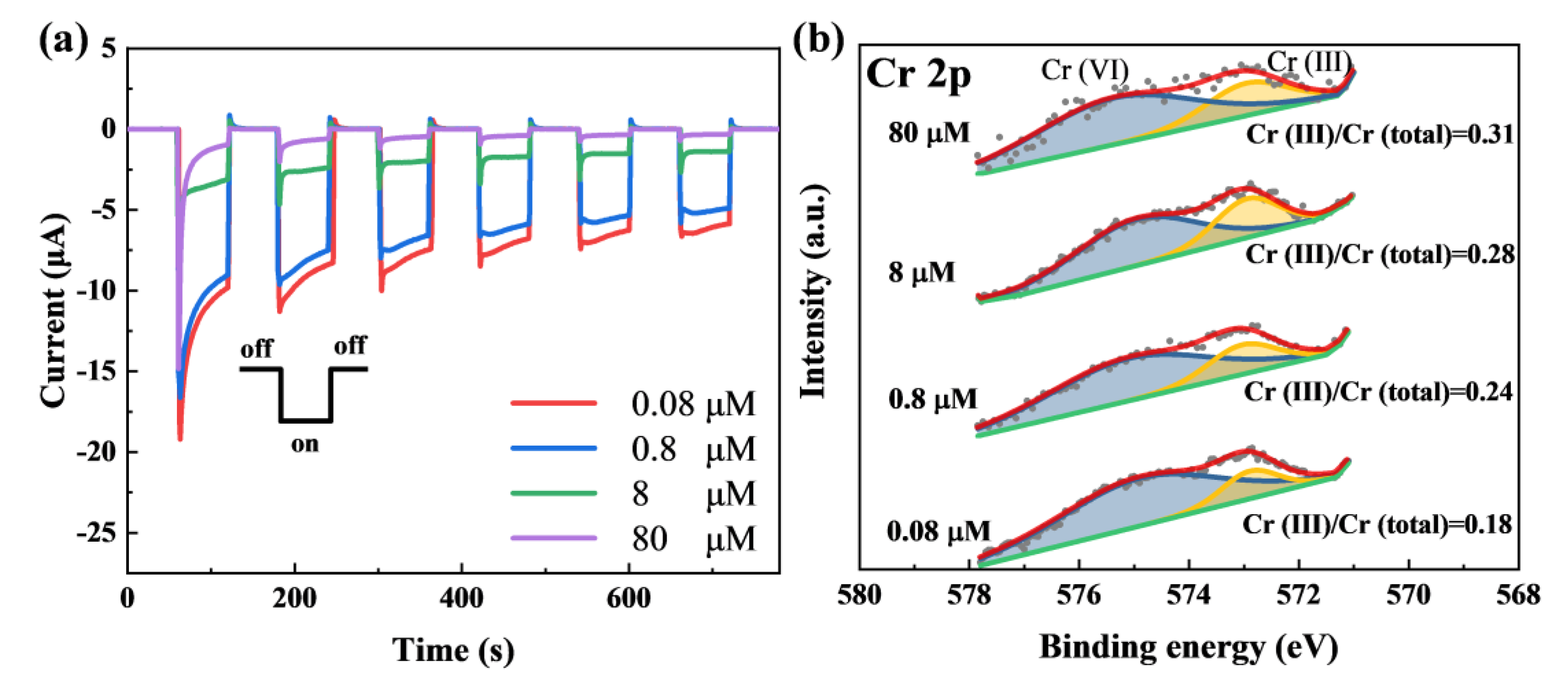
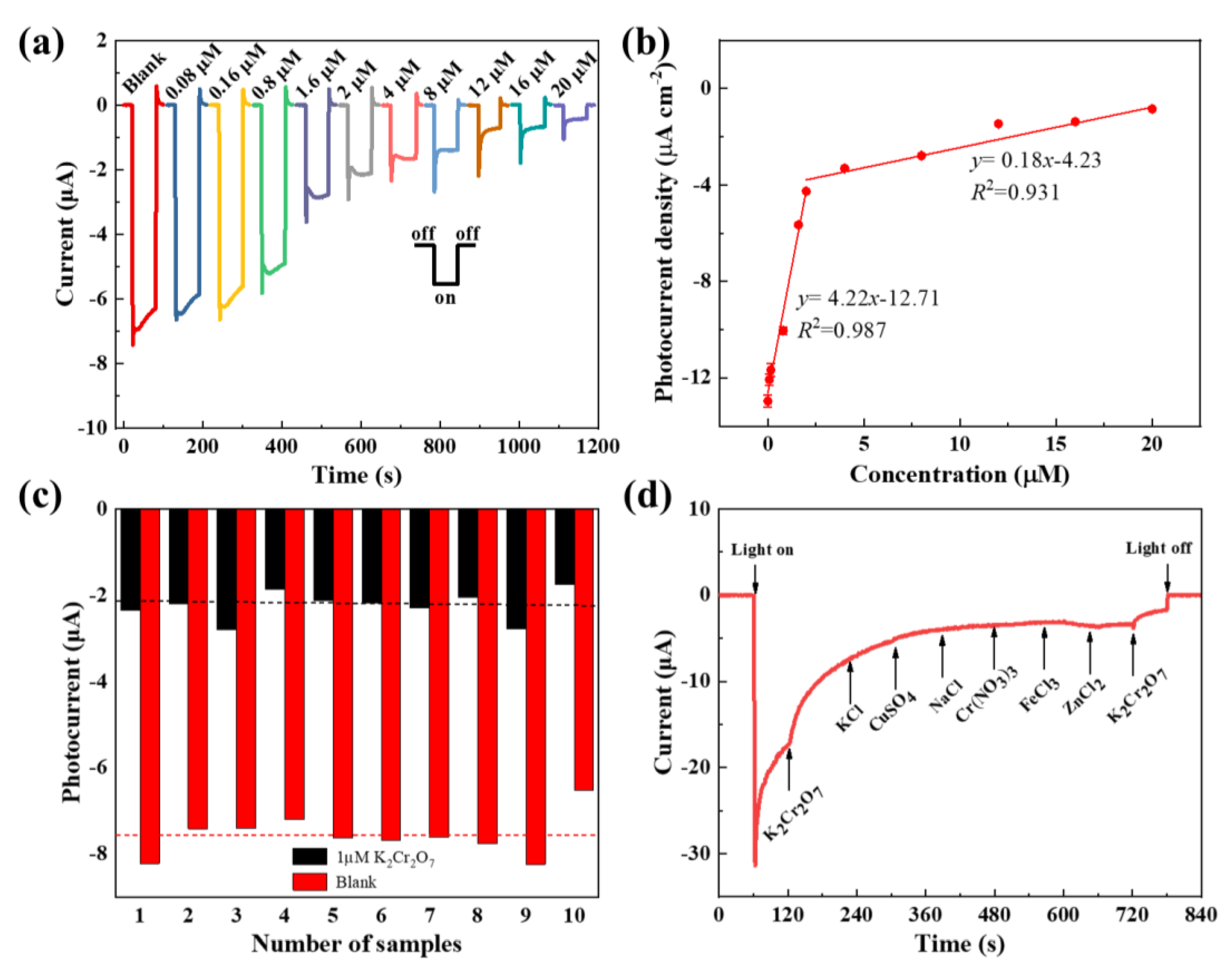
| Testing Time (min) | Immersion Time (min) | Cr(VI) Concentration (µM) | |||||||||||
|---|---|---|---|---|---|---|---|---|---|---|---|---|---|
| 40 | 60 | 80 | 0 | 20 | 40 | 0.08 | 0.16 | 0.8 | 4 | 12 | 16 | ||
| Rs (Ω) | 47.58 | 46.95 | 47.55 | 55.16 | 47.6 | 50.25 | 53.04 | 47.89 | 49.7 | 51.9 | 52.86 | 50.51 | |
| Rct (Ω) | 55.46 | 134.6 | 277.4 | 85.81 | 109.5 | 156.1 | 92.74 | 131.8 | 136.2 | 206.4 | 968.5 | 1917 | |
Disclaimer/Publisher’s Note: The statements, opinions and data contained in all publications are solely those of the individual author(s) and contributor(s) and not of MDPI and/or the editor(s). MDPI and/or the editor(s) disclaim responsibility for any injury to people or property resulting from any ideas, methods, instructions or products referred to in the content. |
© 2023 by the authors. Licensee MDPI, Basel, Switzerland. This article is an open access article distributed under the terms and conditions of the Creative Commons Attribution (CC BY) license (https://creativecommons.org/licenses/by/4.0/).
Share and Cite
Lu, W.; Ma, L.; Ke, S.; Zhang, R.; Zhu, W.; Qin, L.; Wu, S. Unbiased and Signal-Weakening Photoelectrochemical Hexavalent Chromium Sensing via a CuO Film Photocathode. Nanomaterials 2023, 13, 1479. https://doi.org/10.3390/nano13091479
Lu W, Ma L, Ke S, Zhang R, Zhu W, Qin L, Wu S. Unbiased and Signal-Weakening Photoelectrochemical Hexavalent Chromium Sensing via a CuO Film Photocathode. Nanomaterials. 2023; 13(9):1479. https://doi.org/10.3390/nano13091479
Chicago/Turabian StyleLu, Wenxiang, Lu Ma, Shengchen Ke, Rouxi Zhang, Weijian Zhu, Linling Qin, and Shaolong Wu. 2023. "Unbiased and Signal-Weakening Photoelectrochemical Hexavalent Chromium Sensing via a CuO Film Photocathode" Nanomaterials 13, no. 9: 1479. https://doi.org/10.3390/nano13091479
APA StyleLu, W., Ma, L., Ke, S., Zhang, R., Zhu, W., Qin, L., & Wu, S. (2023). Unbiased and Signal-Weakening Photoelectrochemical Hexavalent Chromium Sensing via a CuO Film Photocathode. Nanomaterials, 13(9), 1479. https://doi.org/10.3390/nano13091479









